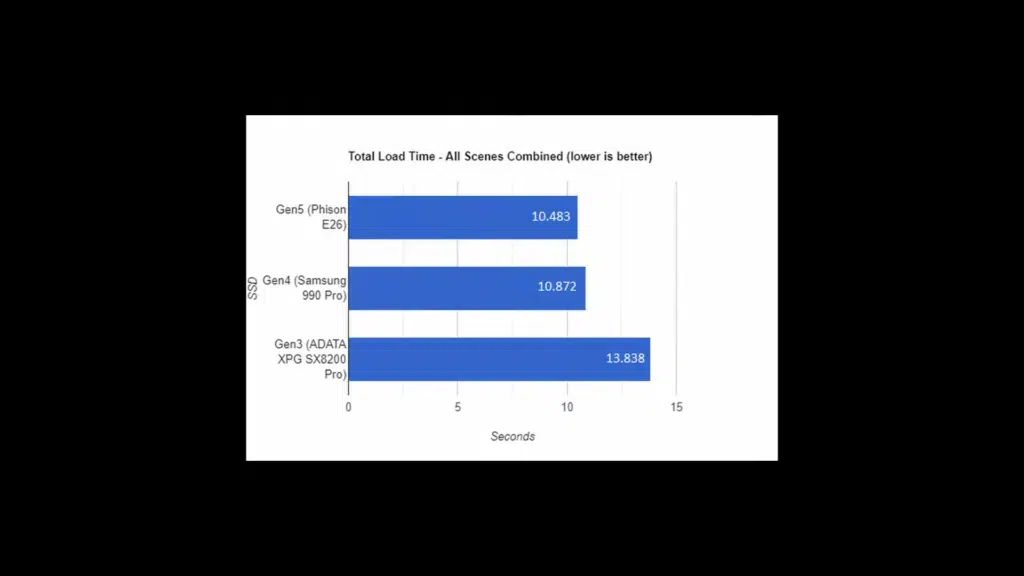
Compusemble has benchmarked three generations of NVMe PCIe SSDs to see how they perform in Forspoken, the new fantasy RPG from Square Enix that supports DirectStorage (1.1), Microsoft’s new API that enables improved loading times with developments that include GPU decompression. The results suggest that players will find minimal difference between Gen 3 and Gen 5 SSDs, and barely any difference between Gen 4 and Gen 5 SSDs. Benchmarks that Digital Foundry shared earlier this week tease loading times as low as 4.1 seconds for a 13th Gen Intel Core i9-12900K system with PCIe 3.0 SSD.
From a Compusemble video:
Forspoken is the first game to support DirectStorage on PC. Last week, I tested the game on the fastest SSD available – the Phison E26 Gen5 SSD. Today, I compare 3 generations of NVMe PCIe SSDs in Forspoken – Gen5 vs Gen4 vs Gen3. The comparison is performed in the game’s built-in benchmark, and a total load time across all 7 scenes is presented and compared at the end of the video.
The SSDs used in this comparison are:
- Gen5: Phison E26
- Gen4: Samsung 990 Pro
- Gen3: ADATA XPG SX8200 Pro
The Gen5 SSD in this video (Phison E26 engineering sample) is using Micron’s 232L NAND which supports up to 2400 MT/s. However, the Phison E26 SSD is only using 1600 MT/s. So in Q2 and beyond, once E26 based Gen5 SSDs hit the market, you will see even faster drives with 2000 MT/s and 2400 MT/s NAND.
System specs:
- RTX 3080 Ti
- Ryzen 7 7700X
- 32 GB Corsair Vengeance DDR5
- ASUS ROG STRIX B650E-F GAMING WiFi
- Phison E26 Engineering Sample SSD Gen5
- Samsung 990 Pro SSD Gen4
- ADATA XPG SX8200 Pro SSD Gen3
- Seasonic Focus GX-1000
- Arctic Freezer 34 CO
- Phanteks Eclipse P500A DRGB
- Windows 11
From a DigitalFoundry Report:
| System | Load time |
|---|---|
| PS5 (performance mode) | 4.4s |
| PC, DirectStorage enabled (Core i9 12900K + NVMe SSD) | 4.1s |
| PC, DirectStorage disabled (Core i9 12900K + NVMe SSD) | 5.4s |
| PC, DirectStorage enabled (Ryzen 5 3600 + NVMe SSD) | 6.8s |
| PC, DirectStorage disabled (Ryzen 5 3600 + NVMe SSD) | 11.7s |
| PC, DirectStorage enabled (Core i9 12900K + SATA SSD) | 10.2s |
When loading the exact same save from the same area, we can see a 3.5GB/s (PCIe 3.0) SSD loads the game faster than on PS5 (4.1s vs 4.4s); with DirectStorage disabled with a command line option, the same load takes around 25 percent longer (5.4s), making it slower than PS5. That’s with a fast 12900K processor though; the same drive used with an older, slower Ryzen 5 3600 still benefits from DirectStorage (6.7s enabled vs 11.7s disabled) but loads do take longer. So DirectStorage helps, but CPU speed is also a factor. Similarly, SATA drives also benefit from DirectStorage, but in my testing a SATA SSD took more than twice as long to load the game as the NVMe SSD (10.2s on SATA vs 4.1s on NVMe). Finally, Windows 11 offers better loading performance than Windows 10, with game loads finishing two seconds faster on Windows 11 with DirectStorage on (6.8s vs 8.8s), and essentially the same speed with DirectStorage off (~11.8s).

